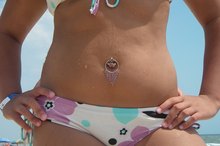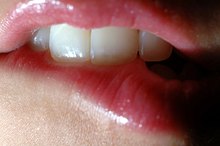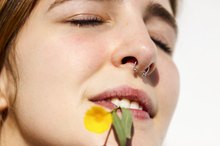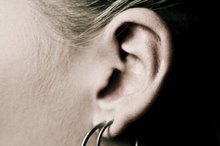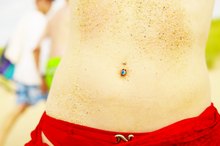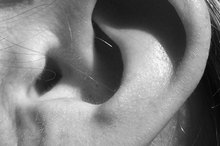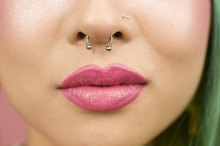What Are the Dangers of Nose Rings?
Nose rings aren’t just edgy fashion accessories for the Western world. Based on the healing science Ayurveda, Indian women wear them in the left nostril to aid in childbirth and ease menstrual pain, according to Painful Pleasures. Middle Eastern Bedouins and African Berber and Beja tribes present nose rings to brides as security, in case of divorce. Despite the rich cultural history, getting and wearing a nose ring does pose some danger to your health.
If you are experiencing serious medical symptoms, seek emergency treatment immediately.
Nose Ring Types
Typically, people wear nose rings in the septum--like a bull ring--or in the nostril. Septum rings usually pierce the soft tissue instead of cartilage, but not always. Nostril rings go through cartilage. Cartilage piercing can lead to a hematoma, the American Academy of Family Physicians warns, which is when a broken blood vessel fills the tissue with blood 3. Necrosis, or dead cells, is another danger of nasal cartilage piercing.
- Typically, people wear nose rings in the septum--like a bull ring--or in the nostril.
- Cartilage piercing can lead to a hematoma, the American Academy of Family Physicians warns, which is when a broken blood vessel fills the tissue with blood 3.
Before You Get Pierced
Aftercare Instructions for Navel Piercing
Learn More
Nose piercings can lead to infections, including Staphylococcus, which sometimes lives in the nose prior to infection. People with diabetes and those taking corticosteroids have a have an increased risk of infection, according to the American Academy of Family Physicians 3. Nose piercing can also result in scarring, particularly in people prone to raised keloid scars.
Before getting a nose ring, check with your doctor if have diabetes, heart disease, allergies, an immune system disorder or other medical conditions, recommends The Nemours Foundation’s TeensHealth 2. It also suggests making sure your tetanus and hepatitis B immunizations are current.
- Nose piercings can lead to infections, including Staphylococcus, which sometimes lives in the nose prior to infection.
- People with diabetes and those taking corticosteroids have a have an increased risk of infection, according to the American Academy of Family Physicians 3.
How to Avoid Infections
Reduce your chances of infection or scarring by having your nose pierced by a reputable piercer. Never do it yourself, and never allow anyone to pierce your nose with a piercing gun. The piercer should wear gloves, clean the piercing area and use a sterile, new needle from a sealed packet. Tell your piercer about any metal allergies you have, TeensHealth suggests, and follow all cleaning and aftercare instructions to the letter 2.
- Reduce your chances of infection or scarring by having your nose pierced by a reputable piercer.
- Never do it yourself, and never allow anyone to pierce your nose with a piercing gun.
Let Your Nose Piercing Heal
Do Nose Piercings Leave Scars?
Learn More
You might love the idea of changing your nose ring as often as you change clothes, but you must give new piercings time to heal. For new septum piercings, wait two to six weeks before removing or changing your nose ring, The Piercerie cautions. Allow four to six months before removing or changing a nostril ring.
Nose Ring Dos and Don'ts
Be careful pulling shirts over your head, especially open-weave or nubby knits. If you snag your nose ring, you could tear it all the way out, leaving a painful and disfiguring injury. Beware also of young children at the grabby stage. Tearing can require stitches or surgery.
Nose rings can also migrate, the American Academy of Family Physicians warns 3. If yours looks like it’s moving forward, contact your doctor and piercer.
- Be careful pulling shirts over your head, especially open-weave or nubby knits.
- Beware also of young children at the grabby stage.
Related Articles
References
- University of Maryland Medical Center: Ayurveda
- TeensHealth: Body Piercing
- American Academy of Family Physicians: Complications of Body Piercing
- Gabriel OT, Anthony OO, Paul EA, Ayodele SO. Trends and complications of ear piercing among selected Nigerian population. J Family Med Prim Care. 2017;6(3):517–521. doi:10.4103/2249-4863.222045
- Uter W, Werfel T, White IR, Johansen JD. Contact allergy: A review of current problems from a clinical perspective. Int J Environ Res Public Health. 2018;15(6):1108. doi:10.3390/ijerph15061108
- Park JK, Kim KS, Kim SH, Choi J, Yang JY. Reconstruction of a traumatic cleft earlobe using a combination of the inverted V-shaped excision technique and vertical mattress suture method. Arch Craniofac Surg. 2017;18(4):277-281. doi:10.7181/acfs.2017.18.4.277
Writer Bio
Leah James has been a full-time freelance writer and editor since 2008. With more than a decade of experience in interior decorating, she frequently writes about home design. She studied English literature at Lyon College.
